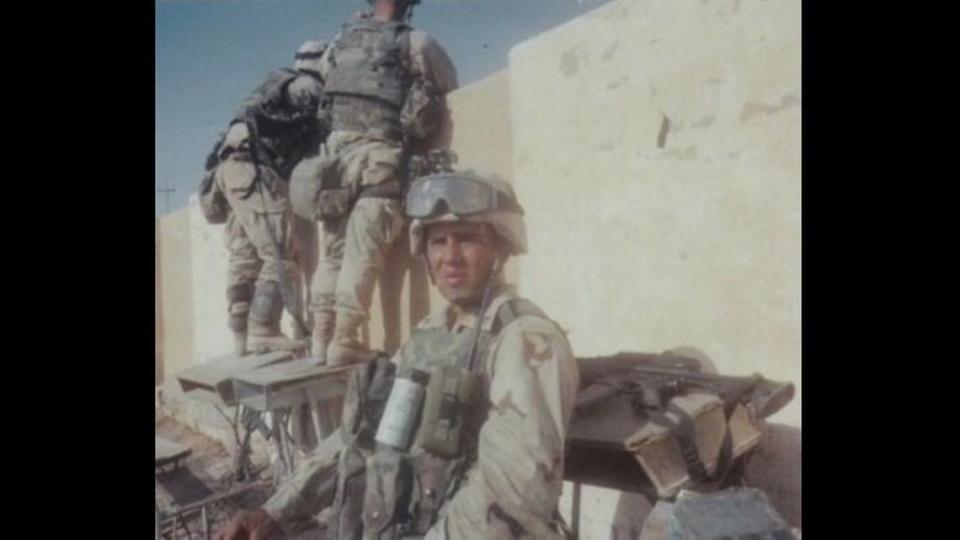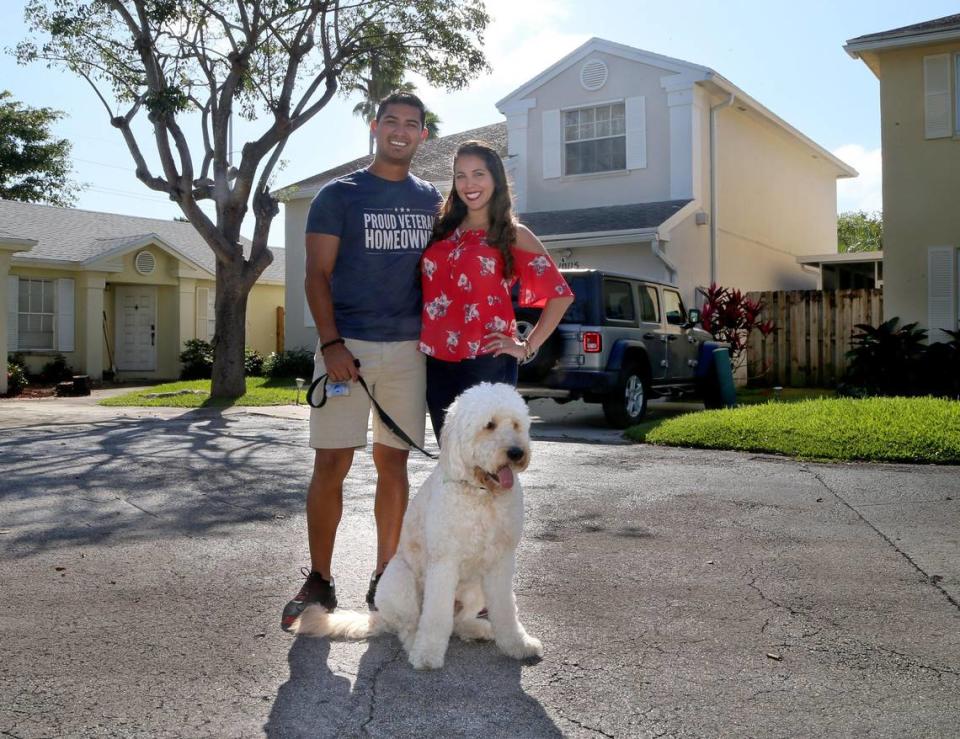Thanks to this new law, home ownership among millennial veterans is on the rise
Ahmed Madriz was 18 years old when he joined the U.S. Army in September 2000. During his five years of service, he was deployed to Kosovo in 2001 and Kuwait in 2003, when American troops invaded Iraq.
After his first marriage ended in 2005, Madriz left the military to raise his two sons. In 2019, he was living in Homestead with his second wife, Joan, and their new infant daughter, paying $1,400 a month in rent for a three-bedroom townhouse.
Then Joan announced she was pregnant. Another baby was on the way.
“We had already been saving for about a year,” Madriz, 38, said. “So we decided it was time to get a bigger place. Our townhouse was already tight as it was.”
The family began searching for something under $450,000 — a price that qualified for a no-down-payment Veteran Affairs home loan in 2019. Their options were slim.
The latest data from Berkshire Hathaway HomeServices EWM Realty shows that the percentage of Miami-Dade single-family homes priced under $300,000 and listed for sale in the Southeast Florida Regional Multiple Listing Service (MLS) has been steadily declining for the past decade, when compared with homes for sale in all price ranges.
The number of single-family homes for sale under $300,000 on Dec. 31, 2019, totaled 719 homes, which represented 12% of all homes for sale. Just 10 years ago, homes in this same price range accounted for 52% of all homes for sale on Dec. 31, 2009.
Homes in the $300,000-$599,999 price range are also becoming scarce, with an existing inventory of only four months (six to nine months is considered a healthy market).
Rising cost of housing
Now, in response to the ballooning costs of single-family homes and condos around the U.S., veterans no longer have a price cap on a zero-down home loan. The change, which went into effect on Jan. 1, 2020, is part of the federal Blue Water Navy Vietnam Veterans Act of 2019 signed into law last June.
Under the program, qualifying veterans with sufficient income and credit get a no-down-payment loan when buying their home.
“Previously, veterans could still apply for a no-down-payment loan for a home that exceeded the cap,” said Chris Birk, director of education for Veterans United Home Loans, the country’s largest VA lender. “But they would have to make a down payment covering 25 percent of the difference between the loan limit and the sales price.
“The price cap in 2019 for how much you could borrow was $484,350. So if you wanted to buy a $584,000 home, you had to put a $25,000 down payment,” Birk said. “That was still an incredible deal. But there were still veterans who were getting priced out.”
VA loans are zero-down mortgage options issued by private lenders and backed by the Department of Veterans Affairs. The loans are only usable for primary residences, not investment properties. But they can also be used to refinance an existing mortgage.
Eligibility
In order to be eligible for a VA loan, the applicant must meet one of the following requirements:
▪ Served 90 consecutive days of active service during wartime
▪ Served 181 days of active service during peacetime
▪ Served six years in the National Guard or reserves
▪ Be the spouse of a service member who died in the line of duty or a service-connected disability
According to the Department of Veteran Affairs, more than 24 million service members have used VA loans to become homeowners since 1944, when the program was first introduced as part of the G.I. Bill, drafted to help World War II veterans with housing and college costs.
While millennials are increasingly shying away from early home ownership due to down payment requirements, the number of veterans who are becoming homeowners is growing at a steady clip.
Nationwide, VA home loans topped 624,000 in 2019, a 43 percent increase from 2014. The Miami-Fort Lauderdale-Pompano Beach area ranked 26th on a list of the Top 30 Cities for VA Loan Usage in the fiscal year 2019 (Oct. 1-Sept. 30), with 4,720 loans issued (a 56 percent increase from 2014).
According to the U.S. Department of Veteran Affairs, Florida is home to 1,594,218 veterans, behind only California (1,789,862) and Texas (1,603,328). About 244,000 of Florida’s veterans are between the ages of 25 and 45.
As of Sept. 30, 2019, Miami-Dade is home to 55,416 veterans, while 74,707 live in Broward.
Despite Miami-Dade’s notoriously high cost of living, veterans are finding options they can afford thanks to the program.

The Madrizes spent three months looking at 50 potential homes before settling on a four-bedroom, two-and-a-half bath home in West Kendall for $439,000. The house met all of the family’s requirements: more than 2,000 square feet of living space, a big yard and move-in turnkey condition, because the new baby could not be exposed to remodeling dust and noise.
“Even with no down payment, our closing costs would have been almost $20,000,” said Madriz, whose broker was able to secure a 2.5 percent seller’s contribution. “I don’t know how normal people do it. You have to put down $60,000 or more just to buy a house.”
Homeownership as investment
The program also enabled Jhon Ospina, 27, and his girlfriend, Angela, to stop renting and become homeowners.
Ospina served in the U.S. Air Force Reserve from 2012-2018. He and Angela were paying $1,400 for a one-bedroom apartment in Doral last year when they decided to buy a place together.
“I didn’t want to keep paying someone else’s mortgage,” Ospina said. “The sooner I become a homeowner, the more I can invest toward my retirement.”

Although the couple was pre-approved for $350,000, they opted to look for something in the $280,000 range so they wouldn’t be “house broke.” They settled on a three-bedroom, two-bath home on 107th Court in Kendall with an aging roof for $315,000. The sale closed in March 2019. The couple paid $7,000 in closing costs. They were married in January.
“People wait until their thirties or even their forties because they think buying a house is too expensive,” he said. “But if you’re a veteran, you don’t have to save a crazy amount of money. I have friends who still live with Mom and Dad. They are buying expensive cars and going out to eat at expensive restaurants. But once you buy a house, you’re building a savings account.”

